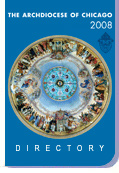|
|
Chicago, Mexico build on foundation of collaboration
By Michael D. Wamble
STAFF WRITER
|
|
|
|
 |
|
Carmen Macias joins more than 200 Chicago Catholic pilgrims at
O'Hare Airport en route to Mexico. |
|
When the Virgin Mary visited Juan Diego in 1531 in the northwestern
hills outside Mexico City, she instructed a poverty-stricken Aztec
to ask the local bishop to build a house of worship upon the site.
Nearly 500 years later, two cardinals continue to answer that
call by laying a foundation for a house of religious solidarity
in the two geographically and culturally different, yet similar
regions Pope John Paul II defined as one in his 1997 “Ecclesia
in America.”
On Dec. 12, the feast day of Our Lady of Guadalupe, the Archdiocese
of Chicago deepened its relationship with its sister archdiocese,
Mexico City, together imploring the patroness of America, “Mary
of Guadalupe, Star of Evangelization” to “give us strength to
announce the Good News with courage.”
More than 200 Chicago-area Catholics led by Cardinal George witnessed
their shepherd close an historic four-day Mexico pilgrimage by
approving an agreement that opened lines of general communication
to implement specific areas for collaboration with Mexico City,
the world’s most populous archdiocese.
Areas of collaboration include, but are not limited to: exchanges
of processes and programs of general evangelization and catechesis;
evangelization and catechesis for developmentally disabled persons;
Biblical diffusion through the “Bible of America”; and reflection
and dialogue to enrich programs for urban pastoral ministry.
During his May 1999 visit to Chicago, Cardinal Norberto Rivera
entered into formal declarations of cooperation with Cardinal
George linking their archdiocesan Catholic Charities offices and
complementary social service agencies in joint projects.
The first result of that agreement has taken physical form in
the Cardinal Francis George House of Adoption, a temporary home
for children awaiting legal certification for family reunification
or adoption. The building serves as the first adoption home for
children over age 6 in Mexico City.
The Dec. 12 agreement, said Father John E. Pollard, outgoing archdiocesan
director of evangelization and catechesis, is “the second step”
in answering the pope’s challenge to foster “ecclesial communion”
between Catholics in these large, primarily urban archdioceses.
“Mexico City is a perfect match for Chicago in many ways,” said
Pollard. “With so many people, nearly one million Spanish-speaking
Catholics, many who have immigrated from Mexico, there is a natural
affinity and fraternity that exists between our two local churches.”
“This agreement will concretize exchanges of information, resources,
personnel, ideas and materials. It is a doorway between ourselves
and Mexico City, a large urban church, similar to us in so many
ways,” said Pollard, who also signed the document along with his
Mexican counterpart, Juan Carlos Guerrero Ugalde.
One of the most visible similarities shared by Catholics in Chicago
and Mexico City is a deep devotion to Mary, a characteristic often
culturally attributed to Mexican Catholics.
It is a devotion that drops many of the faithful to their knees
before they even enter Mexico City’s Basilica of Our Lady of Guadalupe.
In the hours leading to midnight, Dec. 12, in the basilica, just
as in Our Lady of Tepeyac Parish in Chicago, the faithful reenacted
the 1531 apparition and serenaded images of the brown-skinned
mestizo virgin bathed in candlelight.
The only differences in both expressions were size and scale.
In Chicago, seven parishes from the Little Village came together.
In Mexico more than 10 million Catholics from as far away as France,
Poland, Argentina and Austria emerged from sleeping bags and temporary
camps outside the basilica to form one voice singing her praise
in the traditional “Las Mananitas” (literally Spanish for “Happy
Birthday”).
Maria Del Carmen Macias, editor of Chicago Catolico, the Spanish-language
publication for the Chicago Archdiocese, described the late night
ceremony as “breathtaking.”
She said, “There are the crowds, the candles, the costumes, the
indigenous pre-Hispanic dancers, and the images, the images everywhere
of Our Lady of Guadalupe, create such a beautiful experience.
It gave me goose-bumps.”
Macias said Cardinal George told the massive congregation in fluent
Spanish that he was “aware of the ground my feet are on” that
surface being “one of the most holiest shrines.
“There were tearful faces in the basilica,” she said. “You get
the sense, as Cardinal George said, he understands that it is
not enough to know a language, but one must know the culture that
has formed this deep devotion.”
To that extent, Macias, said a husband and wife of Columbian heritage
traveling with the Chicago pilgrims describe themselves as “adopted
Mexicans” due to their devotion to Mary. While the couple has
previously journeyed to Lourdes and Fatima, Macias said they told
her nothing compared to this visit.
Pollard said it is essential to be mindful that the spirit of
cooperation constructed in the place where Mary appeared to the
people of America.
“To understand what has happened here, it is quite important to
note that our agreement concludes with a prayer to Our Lady of
Guadalupe,” said Pollard. “As pilgrims and pastoral representatives
we must be concrete symbols of solidarity to strengthen the ties
between these local churches.”
Next week: Continued coverage and photos of the historic Mexico
City pilgrimage.
Front Page | Digest | Cardinal | Interview
Classifieds | About Us | Write Us | Subscribe | Advertise
Archive | Catholic Sites | New World Publications | Católico | Directory | Site Map
|





